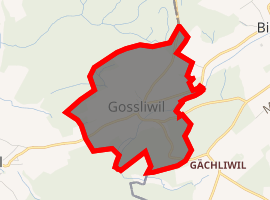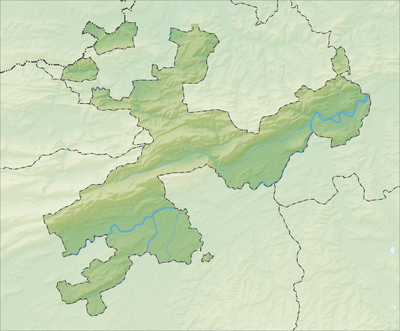Gossliwil
Gossliwil is a former municipality in the district of Bucheggberg, in the canton of Solothurn, Switzerland. On 1 January 2014 the former municipalities of Gossliwil, Tscheppach, Brügglen, Aetingen, Aetigkofen, Bibern (SO), Hessigkofen, Mühledorf (SO), Küttigkofen, Kyburg-Buchegg merged into the new municipality of Buchegg.[1]
Gossliwil | |
|---|---|
 Coat of arms | |
Location of Gossliwil 
| |
 Gossliwil  Gossliwil | |
| Coordinates: 47°8′N 7°26′E | |
| Country | Switzerland |
| Canton | Solothurn |
| District | Bucheggberg |
| Area | |
| • Total | 1.98 km2 (0.76 sq mi) |
| Elevation | 539 m (1,768 ft) |
| Population (Dec 2011) | |
| • Total | 194 |
| • Density | 98/km2 (250/sq mi) |
| Postal code | 4579 |
| SFOS number | 2449 |
| Surrounded by | Bibern, Hessigkofen, Lüterswil-Gächliwil, Oberwil bei Büren (BE), Rüti bei Büren (BE) |
| Website | www SFSO statistics |
History
Gossliwil is first mentioned in 1246 as Gosseriswile. In 1276 it was mentioned as Goselwyl.[2]
Geography
Before the merger, Gossliwil had a total area of 2.0 km2 (0.77 sq mi).[3] Of this area, 1.16 km2 (0.45 sq mi) or 59.8% is used for agricultural purposes, while 0.66 km2 (0.25 sq mi) or 34.0% is forested. Of the rest of the land, 0.15 km2 (37 acres) or 7.7% is settled (buildings or roads).[4]
Of the built up area, housing and buildings made up 3.6% and transportation infrastructure made up 4.1%. Out of the forested land, all of the forested land area is covered with heavy forests. Of the agricultural land, 41.2% is used for growing crops and 17.5% is pastures.[4]
The former municipality is located in the Bucheggberg district, on a plateau near the source of the Biberenbach river.
Coat of arms
The blazon of the municipal coat of arms is Gules a Garb Or issuant from a Mount of 3 Coupeaux Vert surrounded with three Cinquefoils of the second, one and two.[5]
Demographics
Gossliwil had a population (as of 2011) of 194.[3] As of 2008, 1.5% of the population are resident foreign nationals.[6] Over the last 10 years (1999–2009 ) the population has changed at a rate of -1.5%.[3]
Most of the population (as of 2000) speaks German (183 or 97.3%), with Albanian being second most common (4 or 2.1%) and Portuguese being third (1 or 0.5%).[7]
As of 2008, the gender distribution of the population was 49.7% male and 50.3% female. The population was made up of 96 Swiss men (49.2% of the population) and 1 (0.5%) non-Swiss men. There were 97 Swiss women (49.7%) and 1 (0.5%) non-Swiss women.[8] Of the population in the municipality 78 or about 41.5% were born in Gossliwil and lived there in 2000. There were 34 or 18.1% who were born in the same canton, while 65 or 34.6% were born somewhere else in Switzerland, and 8 or 4.3% were born outside of Switzerland.[7]
In 2008 there was 1 live birth to Swiss citizens and 1 death of a Swiss citizen. Ignoring immigration and emigration, the population of Swiss citizens remained the same and the foreign population remained the same. There was 1 Swiss man who immigrated back to Switzerland. The total Swiss population change in 2008 (from all sources, including moves across municipal borders) was an increase of 4 and the non-Swiss population remained the same. This represents a population growth rate of 2.0%.[6]
The age distribution, as of 2000, in Gossliwil is; 22 children or 11.7% of the population are between 0 and 6 years old and 25 teenagers or 13.3% are between 7 and 19. Of the adult population, 10 people or 5.3% of the population are between 20 and 24 years old. 60 people or 31.9% are between 25 and 44, and 39 people or 20.7% are between 45 and 64. The senior population distribution is 24 people or 12.8% of the population are between 65 and 79 years old and there are 8 people or 4.3% who are over 80.[9]
As of 2000, there were 79 people who were single and never married in the municipality. There were 94 married individuals, 8 widows or widowers and 7 individuals who are divorced.[7]
In 2000 there were 19 single family homes (or 35.2% of the total) out of a total of 54 inhabited buildings. There were 14 multi-family buildings (25.9%), along with 19 multi-purpose buildings that were mostly used for housing (35.2%) and 2 other use buildings (commercial or industrial) that also had some housing (3.7%).[10]
In 2000 there were 85 apartments in the municipality. Of these apartments, a total of 74 apartments (87.1% of the total) were permanently occupied, while 7 apartments (8.2%) were seasonally occupied and 4 apartments (4.7%) were empty.[10] As of 2009, the construction rate of new housing units was 0 new units per 1000 residents.[3] The vacancy rate for the municipality, in 2010, was 0%.[3]
The historical population is given in the following chart:[2][11]

Politics
In the 2007 federal election the most popular party was the SVP which received 37.3% of the vote. The next three most popular parties were the FDP (24.39%), the CVP (15.16%) and the SP (11.89%). In the federal election, a total of 73 votes were cast, and the voter turnout was 49.3%.[12]
Economy
As of 2010, Gossliwil had an unemployment rate of 1.4%. As of 2008, there were 25 people employed in the primary economic sector and about 10 businesses involved in this sector. 2 people were employed in the secondary sector and there were 2 businesses in this sector. 6 people were employed in the tertiary sector, with 2 businesses in this sector.[3] There were 97 residents of the municipality who were employed in some capacity, of which females made up 42.3% of the workforce.
In 2008 the total number of full-time equivalent jobs was 19. The number of jobs in the primary sector was 15, all of which were in agriculture. The number of jobs in the secondary sector was 2 of which 1 was in manufacturing and 1 was in construction. The number of jobs in the tertiary sector was 2. In the tertiary sector; both jobs were in a hotel or restaurant.[13]
In 2000, there were 4 workers who commuted into the municipality and 77 workers who commuted away. The municipality is a net exporter of workers, with about 19.3 workers leaving the municipality for every one entering.[14] Of the working population, 5.2% used public transportation to get to work, and 72.2% used a private car.[3]
Religion
From the 2000 census, 19 or 10.1% were Roman Catholic, while 133 or 70.7% belonged to the Swiss Reformed Church. Of the rest of the population, and there were 3 individuals (or about 1.60% of the population) who belonged to another Christian church. There were 5 (or about 2.66% of the population) who were Islamic. 24 (or about 12.77% of the population) belonged to no church, are agnostic or atheist, and 4 individuals (or about 2.13% of the population) did not answer the question.[7]
Education
In Gossliwil about 68 or (36.2%) of the population have completed non-mandatory upper secondary education, and 27 or (14.4%) have completed additional higher education (either university or a Fachhochschule). Of the 27 who completed tertiary schooling, 70.4% were Swiss men, 29.6% were Swiss women.[7]
As of 2000, there were 6 students in Gossliwil who came from another municipality, while 20 residents attended schools outside the municipality.[14]
References
- Nomenklaturen – Amtliches Gemeindeverzeichnis der Schweiz (in German) accessed 13 December 2014
- Gossliwil in German, French and Italian in the online Historical Dictionary of Switzerland.
- Swiss Federal Statistical Office Archived 2016-01-05 at the Wayback Machine accessed 8 January 2014
- Swiss Federal Statistical Office-Land Use Statistics 2009 data (in German) accessed 25 March 2010
- Flags of the World.com accessed 19-March-2011
- Swiss Federal Statistical Office - Superweb database - Gemeinde Statistics 1981-2008 Archived 2010-06-28 at the Wayback Machine (in German) accessed 19 June 2010
- STAT-TAB Datenwürfel für Thema 40.3 - 2000 Archived 2014-04-09 at the Wayback Machine (in German) accessed 2 February 2011
- Canton of Solothurn Statistics - Wohnbevölkerung der Gemeinden nach Nationalität und Geschlecht Archived 2011-03-05 at the Wayback Machine (in German) accessed 11 March 2011
- Canton of Solothurn Statistics - Wohnbevölkerung nach Gemeinden, Nationalität, Altersgruppen und Zivilstand, Total (Männer + Frauen) Archived 2011-07-07 at the Wayback Machine (in German) accessed 11 March 2011
- Federal Statistical Office STAT-TAB - Datenwürfel für Thema 09.2 - Gebäude und Wohnungen Archived 2015-01-21 at the Wayback Machine (in German) accessed 28 January 2011
- Swiss Federal Statistical Office STAT-TAB Bevölkerungsentwicklung nach Region, 1850-2000 Archived 2014-09-30 at the Wayback Machine (in German) accessed 29 January 2011
- Swiss Federal Statistical Office, Nationalratswahlen 2007: Stärke der Parteien und Wahlbeteiligung, nach Gemeinden/Bezirk/Canton Archived 2015-05-14 at the Wayback Machine (in German) accessed 28 May 2010
- Swiss Federal Statistical Office STAT-TAB Betriebszählung: Arbeitsstätten nach Gemeinde und NOGA 2008 (Abschnitte), Sektoren 1-3 Archived 2014-12-25 at the Wayback Machine (in German) accessed 28 January 2011
- Swiss Federal Statistical Office - Statweb (in German) accessed 24 June 2010
External links
| Wikimedia Commons has media related to Gossliwil. |
- Gossliwil in German, French and Italian in the online Historical Dictionary of Switzerland.